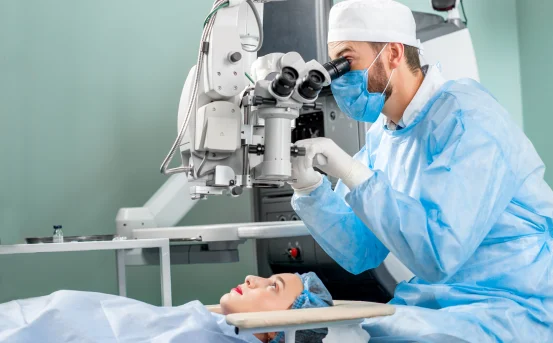Cataract Surgery are one of the most common age-related eye conditions that affect millions of people worldwide. As people grow older, the lenses of their eyes may become cloudy, leading to blurry vision, glare sensitivity, and reduced color perception. This clouding of the eye’s natural lens is known as a cataract. When cataracts interfere with daily life—making it difficult to read, drive, or recognize faces—cataract surgery becomes necessary.
Cataract surgery is one of the safest and most frequently performed procedures in the world. With advances in technology and surgical techniques, it has become a highly successful method for restoring clear vision and improving quality of life.
Understanding What is Cataract Surgery
The eye functions like a camera. Light passes through a clear lens behind the iris (the colored part of the eye), focusing images on the retina at the back of the eye. Over time, the proteins in the eye’s natural lens may begin to clump together, forming cloudy areas that impair vision. This condition is called a cataract.
Cataracts usually develop gradually and may not be noticeable in the early stages. However, as they progress, symptoms such as blurred vision, faded colors, halos around lights, and difficulty seeing at night become more apparent. Although glasses or brighter lighting may help temporarily, surgery is the only definitive treatment.
What is Cataract Surgery?
Cataract surgery is a procedure to remove the eye’s natural lens when it becomes clouded and replace it with a clear artificial lens called an intraocular lens (IOL). The goal is to restore clear, sharp vision and improve contrast sensitivity and color perception.
The procedure is usually performed on an outpatient basis, meaning patients do not need to stay overnight in the hospital. It is typically done under local anesthesia, with patients awake but relaxed during the surgery. Most surgeries take about 15 to 30 minutes per eye, and recovery is generally quick.
Who Needs Cataract Surgery?
Not all cataracts require surgery right away. In the early stages, vision may still be functional with glasses or stronger lighting. However, surgery is recommended when:
- Vision loss affects your daily activities, such as reading, driving, or watching TV
- You experience frequent changes in your glasses prescription
- You struggle with glare from headlights or sunlight
- Your doctor finds significant progression in the cataract during eye exams
Cataract surgery is also performed in cases where the cataract prevents treatment of other eye conditions, such as age-related macular degeneration or diabetic retinopathy.
Types of Cataract Surgery
There are two primary methods used to perform cataract surgery:
Phacoemulsification (Phaco)
This is the most common modern technique. A tiny incision is made in the cornea, and a small probe is inserted into the eye. The probe uses ultrasound waves to break the cloudy lens into tiny pieces, which are then suctioned out. Once the natural lens is removed, the artificial intraocular lens is implanted in its place.
Femtosecond Laser-Assisted Cataract Surgery (FLACS)
In this advanced method, a femtosecond laser is used to make precise incisions and soften the lens before removal. This technique enhances accuracy, reduces surgical time, and may result in faster healing. However, not all patients are candidates for laser-assisted surgery, and it may involve additional costs.
Both techniques are safe and effective, and your ophthalmologist will recommend the best approach based on your eye condition and overall health.
Intraocular Lens (IOL) Options
One of the most important parts of cataract surgery is choosing the right IOL. Different types of artificial lenses offer varying levels of vision correction:
- Monofocal IOLs :- Provide clear vision at one distance (usually far), requiring glasses for reading or computer use.
- Multifocal IOLs :- Designed to offer clear vision at multiple distances, reducing the need for glasses.
- Toric IOLs :- Correct astigmatism and improve overall visual clarity.
- Accommodative IOLs :- Designed to shift focus between near and far objects more naturally.
Your eye surgeon will discuss these options during the preoperative consultation, taking into account your lifestyle, visual needs, and budget.
Before the Surgery: Preparation and Tests
A few weeks before surgery, you’ll undergo a comprehensive eye examination. Measurements of your eye will be taken to determine the appropriate IOL power and placement. Your doctor will ask about any medications you’re taking and advise you if any need to be adjusted.
Patients are typically asked to avoid eating or drinking for several hours before surgery. Antibiotic or anti-inflammatory eye drops may be prescribed to prevent infection and reduce inflammation.
During the Procedure
On the day of the surgery, you’ll receive local anesthesia, usually in the form of eye drops, to numb the eye. You’ll be awake during the procedure but will not feel pain. Some patients may be given a mild sedative to help them relax.
The surgeon makes a small incision in the cornea, removes the clouded lens using ultrasound or laser, and inserts the artificial IOL. The incision is usually self-sealing and does not require stitches.
The entire procedure is quick, and most patients are discharged within a few hours.
Postoperative Recovery and Care
After the surgery, you’ll be given instructions on how to care for your eye. You may be prescribed eye drops to reduce inflammation and prevent infection. Most people notice an improvement in vision within a few days, although it may take several weeks for full visual clarity to be achieved.
During recovery:
- Avoid rubbing your eyes or applying pressure
- Wear an eye shield while sleeping for the first few nights
- Refrain from swimming or using hot tubs for at least two weeks
- Avoid strenuous activity for a few days
Follow-up visits will be scheduled to monitor healing and ensure the eye is recovering well.
Risks and Potential Complications
Cataract surgery is considered one of the safest procedures in medicine, but like all surgeries, it carries some risks. Potential complications may include:
- Infection
- Inflammation
- Retinal detachment
- Swelling in the retina (macular edema)
- Posterior capsule opacification (a cloudy membrane that may form behind the IOL)
Most of these complications are rare and treatable if detected early. Regular follow-up and adhering to postoperative instructions help minimize these risks.
Life After Cataract Surgery
The majority of patients report significant improvement in vision after cataract surgery. Activities that were once difficult—reading, driving, seeing faces—become easier and clearer. Many patients no longer need glasses for distance vision and may only use reading glasses.
Cataract surgery can also improve contrast sensitivity, color perception, and night vision, greatly enhancing quality of life. It is especially beneficial for older adults who want to maintain independence and avoid accidents due to poor eyesight.
Conclusion
Cataract surgery is a highly successful and reliable procedure that can restore clear vision and improve quality of life. With advancements in surgical technology and artificial lens options, patients today have more choices than ever to achieve optimal results.
Whether you’re experiencing early signs of cataracts or have already been advised to consider surgery, it’s essential to consult with a qualified ophthalmologist. With the right planning, preparation, and follow-up care, cataract surgery can offer a life-changing improvement in vision and daily functioning.























